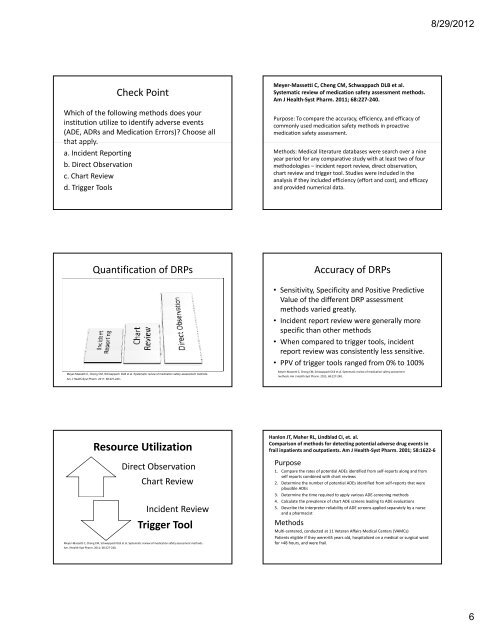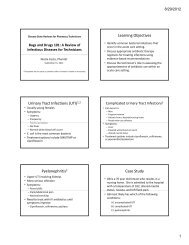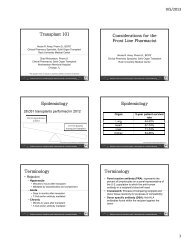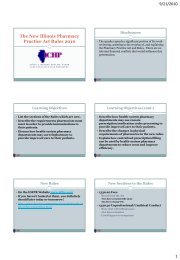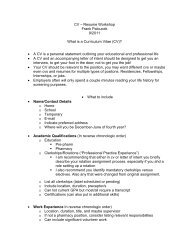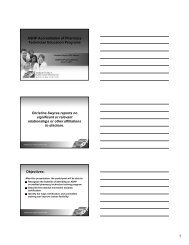Presentation Outline ICHP Annual Meeting September 13-15
Presentation Outline ICHP Annual Meeting September 13-15
Presentation Outline ICHP Annual Meeting September 13-15
Create successful ePaper yourself
Turn your PDF publications into a flip-book with our unique Google optimized e-Paper software.
Check Point<br />
Which of the following methods does your<br />
institution utilize to identify adverse events<br />
(ADE, ADRs and Medication Errors)? Choose all<br />
that apply apply.<br />
a. Incident Reporting<br />
b. Direct Observation<br />
c. Chart Review<br />
d. Trigger Tools<br />
Quantification of DRPs<br />
Meyer-Massetti C, Cheng CM, Schwappach DLB et al. Systematic review of medication safety assessment methods.<br />
Am J Health-Syst Pharm. 2011; 68:227-240.<br />
Resource Utilization<br />
Direct Observation<br />
Chart Review<br />
Incident Review<br />
Trigger Tool<br />
Meyer‐Massetti C, Cheng CM, Schwappach DLB et al. Systematic review of medication safety assessment methods.<br />
Am J Health‐Syst Pharm. 2011; 68:227‐240.<br />
Meyer‐Massetti C, Cheng CM, Schwappach DLB et al.<br />
Systematic review of medication safety assessment methods.<br />
Am J Health‐Syst Pharm. 2011; 68:227‐240.<br />
Purpose: To compare the accuracy, efficiency, and efficacy of<br />
commonly used medication safety methods in proactive<br />
medication safety assessment.<br />
Methods: Medical literature databases were search over a nine<br />
year period for any comparative study with at least two of four<br />
methodologies –incident report review, direct observation,<br />
chart review and trigger tool. Studies were included in the<br />
analysis if they included efficiency (effort and cost), and efficacy<br />
and provided numerical data.<br />
Accuracy of DRPs<br />
• Sensitivity, Specificity and Positive Predictive<br />
Value of the different DRP assessment<br />
methods varied greatly.<br />
• Incident report review were generally more<br />
specific than other methods<br />
• When compared to trigger tools, incident<br />
report review was consistently less sensitive.<br />
• PPV of trigger tools ranged from 0% to 100%<br />
Meyer‐Massetti C, Cheng CM, Schwappach DLB et al. Systematic review of medication safety assessment<br />
methods. Am J Health‐Syst Pharm. 2011; 68:227‐240.<br />
Hanlon JT, Maher RL, Lindblad CI, et. al.<br />
Comparison of methods for detecting potential adverse drug events in<br />
frail inpatients and outpatients. Am J Health‐Syst Pharm. 2001; 58:1622‐6<br />
Purpose<br />
1. Compare the rates of potential ADEs identified from self‐reports along and from<br />
self reports combined with chart reviews<br />
2. Determine the number of potential ADEs identified from self‐reports that were<br />
plausible ADEs<br />
3. Determine the time required to apply various ADE‐screening methods<br />
4. Calculate the prevalence of chart ADE screens leading to ADE evaluations<br />
5. Describe the interpreter reliability of ADE screens applied separately by a nurse<br />
and a pharmacist<br />
Methods<br />
Multi‐centered, conducted at 11 Veteran Affairs Medical Centers (VAMCs)<br />
Patients eligible if they were>65 years old, hospitalized on a medical or surgical ward<br />
for >48 hours, and were frail.<br />
8/29/2012<br />
6


